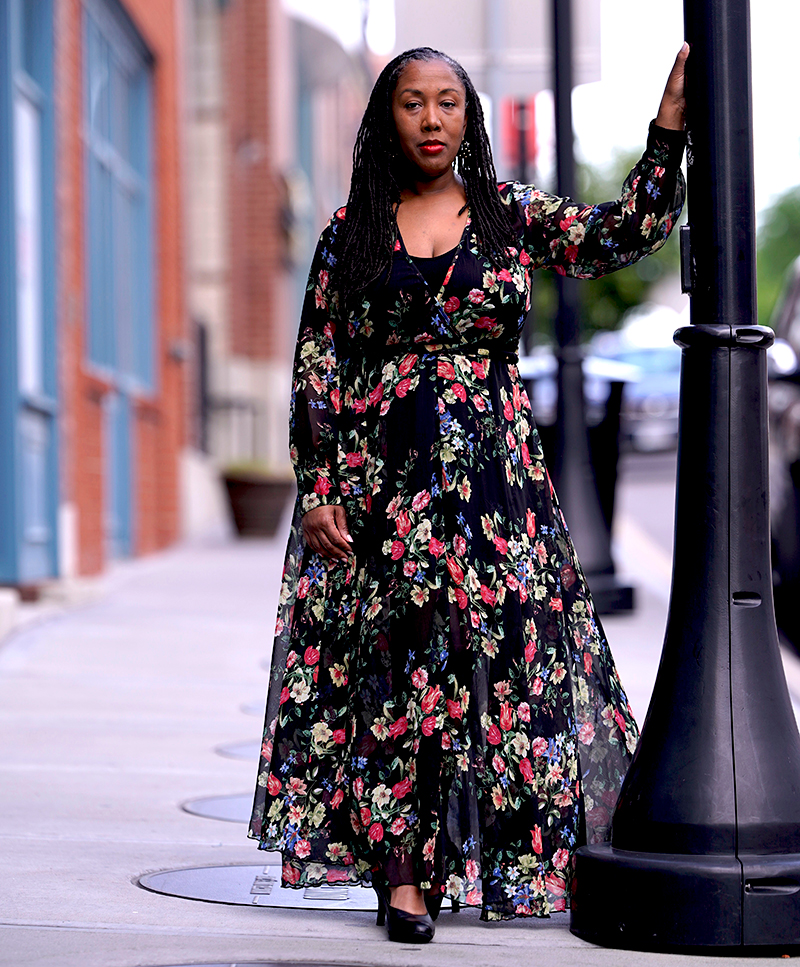
She brings a middle child’s keen observation and adaptability to the task of unlocking the full potential of Kansas City’s American Jazz Museum. Rashida Phillips, who grew up in St. Louis, earned a bachelor’s in English Lit at Oberlin College and a master’s in jazz history at Rutgers, is unencumbered by the reserve that makes it hard for native Kansas Citians to toot their own horn. Phillips worked in the arts in Chicago for 16 years before accepting the executive directorship of the Jazz Museum. She lives in the historic Northeast with her two daughters, ages 14 and 16, who attend Lincoln College Preparatory Academy, and two French bulldogs. In an upbeat phone call with IN Kansas City, she shared what she thinks it will take for Kansas City to harness its globally significant jazz heritage.
You’ve had a high-octane career. What do you do outside of work to recharge?
I love to travel to foreign lands. I’m a big foodie, which means I love all of the eats from all of those cultures. I love the music and the arts, so I really dig in to get the most localized, authentic experience that I can. That’s what I do when I’m home, too. I’m just a geek about the arts. I love theaters and museums and parks.
Do you have any travel on the horizon?
I am hoping and praying I can get to Guadeloupe. My first college roommate at Oberlin College, who was kind of a language nerd, married someone from Guadeloupe and she decided to move there to teach at a secondary school and she said, “Come down and visit us.” How fun is that, to go visit friends and get a little bit of that island culture with a French twist?
Why did you choose to live in the historic Northeast?
I love the culture and the mix of people. It’s always exciting because there are so many different ethnic groups there, and I’m close to the Kansas City Museum, which is beautiful.
You were raised in St. Louis. What neighborhood did you live in?
University City.
What was it like growing up there?
There was a mix of folks. You got kind of the hippie-bohemian life of the Loop, which has all the shops and eateries, which I loved. They have a great library there. I took music lessons—piano and clarinet—at one of the art and music schools in the area, which was great. U City had a real neighborhood feel with folks down the street that you would check in with who would look out for you until the lights came on.
What kind of a kid were you?
I was a good child. I’m one of three, the middle kid. I was the only girl, so I guess I got a little spoiled. I just followed the rules because I knew I could get what I needed if I did. Even if I wanted to do things outside of the rules, I had been so well-behaved my parents would go, “Why not?” as a kind of reward.
When did jazz grab your heart?
When I was a junior in high school I had a jazz role in The 1940s Radio Hour, so I got to study up on all this old-timey, ’40s music. And, oh my gosh, all these great stories and all these great melodies—that was it for me. It was one of those moments in life where the world just opens up.
Why do you think jazz speaks to you more than other genres?
I’m an English Lit major, so I love literature and reading. With jazz, there is such a cadence and a storyline to a lot of the melodies. It’s not as if modern music doesn’t have character or reasoning behind it, but those old songs are so thoughtful. Many of them came from musicals, so there was some kind of action related to it, or some lament. There was drama to the lyrics, and it just transported me into a mood, into a feeling.
You’ve lived as an adult in New York, Chicago, and Kansas City. What kind of experience has that been?
For me it was a reverse migration. New York is often seen as the pinnacle destination for many artists, especially jazz artists. So, starting at the end and working my way back to the beginning was important. Working backwards from New York to Chicago, which is such a vibrant city, was fantastic. And something about that lake really sets the mood.
How would you describe the jazz scene there?
Chicago always felt great to me because it was a balance between the East Coast and the deeper Midwest. It had enough energy, enough vibrancy and more people than St. Louis or Kansas City. So, you would have more jam sessions and more of these venues where people would experiment. There was a lot of experimentation going on. Not just people jamming with each other, but really pushing outside of boundaries. Things like the Art Ensemble of Chicago created an interesting texture of jazz music that was informed by visual arts and dance. There was always collaboration across all the genres.
What appeal did Kansas City hold?
Kansas City was always on the map for me. Coming back to Kansas City, you get a little bit more traditionalist. Not in the sense that it’s old or been-there-done-that, but you get the core, that original push into the modern sound.
I love listening to Charlie Parker and Jay McShann and all of those core people here on the scene, they were striking that match. They took the swing sound, which was so vibrant in dance, and moved it into bebop, which freed it up in different ways. Then Chicago took that and made it even—I don’t want to say stranger, but pushed it even further.
The beauty of the Kansas City sound is that it’s so grounded and so rooted. The blues is so influential here. The blues is influential in Chicago, too, but here it’s a homegrown blues. With folks like Parker or Mary Lou Williams you really get the purity of the music. In New York sometimes it feels like a grind trying to revive that early sound and here it just feels natural.
What do you think it’s going to take to get the American Jazz Museum the kind of national recognition it deserves but that has eluded it?
Kansas City is kind of this place where there’s a little bit of a secret to what’s happening. It’s kind of this enclosed space. But it’s magical. And so, I think Kansas City needs to release itself a little bit. Meaning not be so fearful of change or of modern takeovers, for lack of a better word.
Folks come here from around the world and around the country. They are here, they are poised, and they know our story in terms of jazz. They know who Charlie Parker is in Tokyo. So, they show up with an expectation of a vibrant scene, but it’s gotten a little quiet. And sometimes I think it’s gotten a little quiet because people want to keep it quiet. They don’t want to be overrun and overpopulated. But they’ve got to realize that this export of jazz was a game-changer across the world. Jazz has become an international treasure.
It’s hard for us to wrap our arms around it because it’s not the ’20s through the ’40s anymore. It’s not every other building having music blaring out the door. It’s not playing and jamming at all hours. But there’s something here about the history that’s here to stay. We’ve got to continue to revive it, to unearth it, to move it forward and to really celebrate it for what it is, which is a world phenomenon.
When you lived in Chicago you performed at jazz venues there. Have you performed in Kansas City?
I did a set in the Blue Room last year, and I sang at the Kaw Festival on the river. So, there have been quiet performances. I was always into boutique performances, even in Chicago, because I felt like these were spaces where people would do deep listening. Sometimes the profound lyrics that I love require a deeper ear. I don’t have the time to gig regularly unfortunately, but every performance has been so special. I spend so much time really cultivating and curating the pieces that I sing, whether they are original pieces or whether they are on a theme or there’s something I’m trying to capture about the season.
What do you love about being on stage?
It’s transcendent. In the movie Soul, there was a moment where the main character drifted out of his body and was having an experience where he was playing music but visiting family and doing other things in this dream state. That’s what it’s like on stage. It’s not as if you forget about an audience or forget about the band, but there’s a moment where I feel like I’m floating. It’s euphoric.
What music do you listen to when you’re not working?
With teenagers, I listen to a lot of popular music, [laughs] which is good, because it keeps me real. My kids also appreciate and love jazz. They’ll sing Summertime, or they’ll sing my original songs. And we’ll also turn on the radio and listen to somebody like Lucky Daye, an R&B singer who’s really lyrical and expressive. And people like Somi, an African jazz new music artist who has a beautiful sound. My youngest daughter is really into Tyler, the Creator and Kendrick Lamar. These are rap artists, but their work is so intricate and interesting that I can’t help but be a fan.
Interview condensed and minimally edited for clarity.


